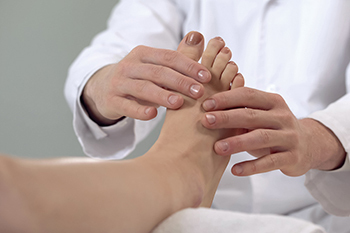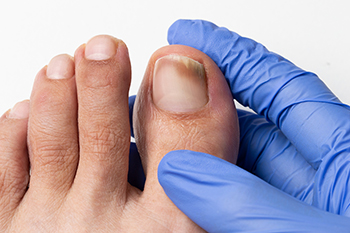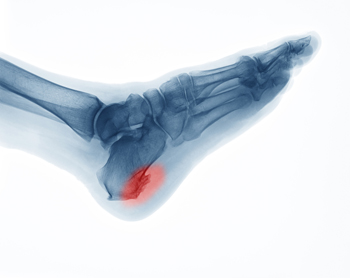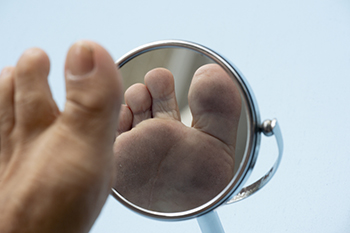Simple Methods For Healthy Feet

Many people throughout the world take their feet for granted. The feet are complex structures and carry the weight of the body. Foot pain can happen when the feet are neglected, and this can make completing daily activities difficult to accomplish. When the feet feel good, a patient's overall attitude may be improved. There are simple methods that can be implemented that the feet can benefit from. These consist of washing the drying the feet daily, followed by using a good moisturizer, which may be helpful in preventing cracked heels. It is imperative that shoes are comfortable and fit correctly, which may be beneficial in helping to avoid unwanted foot conditions. It is suggested that high heels be worn infrequently, and the toenails are trimmed properly. Many people check the bottoms of their feet for existing cuts, bruises, or scrapes, and this is especially important for diabetic patients to do. If you would like more information about the importance of practicing everyday foot care, please confer with a podiatrist who can offer effective tips to maintain the health of the feet.
Everyday foot care is very important to prevent infection and other foot ailments. If you need your feet checked, contact Jim Maxka, DPM from South Penn Foot & Ankle Associates. Our doctor can provide the care you need to keep you pain-free and on your feet.
Everyday Foot Care
Often, people take care of their bodies, face and hair more so than they do for their feet. But the feet are a very important aspect of our bodies, and one that we should pay more attention to. Without our feet, we would not be able to perform most daily tasks.
It is best to check your feet regularly to make sure there are no new bruises or cuts that you may not have noticed before. For dry feet, moisturizer can easily be a remedy and can be applied as often as necessary to the affected areas. Wearing shoes that fit well can also help you maintain good foot health, as well as making it easier to walk and do daily activities without the stress or pain of ill-fitting shoes, high heels, or even flip flops. Wearing clean socks with closed shoes is important to ensure that sweat and bacteria do not accumulate within the shoe. Clean socks help to prevent Athlete’s foot, fungi problems, bad odors, and can absorb sweat.
If you have any questions please feel free to contact our office located in Hanover, PA . We offer the newest diagnostic and treatment technologies for all your foot and ankle needs.
Sources of Toe Pain

People who have pain in their big toe may be unaware it can indicate an underlying medical condition. These can include bunions, ingrown toenails, and gout. A bunion is a deformity that is noticeable from the bony lump that forms on the side of the big toe. Gout is a condition that affects the joints in the big toe and can be extremely painful. An ingrown toenail is often noticed by pain in the big toe and can become infected if prompt treatment is not received. Additionally, there may have been an injury that has happened to the metatarsophalangeal, or MTP joint, and this can cause sharp pain in the big toe. It may be difficult to complete daily activities, and larger shoes may need to be purchased. There are several methods to treat toe pain, and it is strongly suggested that you contact a podiatrist to determine the source of your pain.
Toe pain can disrupt your daily activities. If you have any concerns, contact Jim Maxka, DPM of South Penn Foot & Ankle Associates. Our doctor can provide the care you need to keep you pain-free and on your feet.
What Causes Toe Pain?
Most severe toe pain is caused due to a sports injury, trauma from dropping something heavy on the toe, or bumping into something rigid. Other problems can develop over time for various reasons.
Toe pain can be caused by one or more ailments. The most common include:
- Trauma
- Sports injury
- Wearing shoes that are too tight
- Arthritis
- Gout
- Corns and calluses
- Hammertoe
- Bunions
- Blisters
- Ingrown toenails
- Sprains
- Fractures (broken bones)
- Dislocations
When to See a Podiatrist
- Severe pain
- Persistent pain that lasts more than a week
- Signs of infection
- Continued swelling
- Pain that prevents walking
Diagnosis
In many cases the cause of toe pain is obvious, but in others, a podiatrist may want to use more advanced methods to determine the problem. These can range from simple visual inspections and sensation tests to X-rays and MRI scans. Prior medical history, family medical history, and any recent physical traumatic events will all be taken into consideration for a proper diagnosis.
Treatment
Treatments for toe pain and injuries vary and may include shoe inserts, padding, taping, medicines, injections, and in some cases, surgery. If you believe that you have broken a toe, please see a podiatrist as soon as possible.
If you have any questions please feel free to contact our office located in Hanover, PA . We offer the newest diagnostic tools and technology to treat your foot and ankle needs.
Finding the Right Running Shoe

There are various types of running shoes that are tailored to specific running needs. One of the most important things to look for in a running shoe is a perfect fit. This can be easier to do when the shoes are tried on at the end of the day, when the feet are at their largest. It is necessary to make sure there is adequate room between the toes and the top of the shoe, in addition to choosing the right width. There are three categories of running shoes, and it is beneficial to know what kind of running is most likely to be pursued. An everyday running shoe can handle the type of general running that many people do, and is considered to be the most durable. If faster workouts or running races are preferred, a lightweight shoe may be purchased, and it is made with less cushioning. People who like running on rocky trails or dirt may buy a trail running shoe, which has lugs on the sole that may provide better support than other running shoes. If you have questions about what type of running shoe is best for you, please confer with a podiatrist who can direct you toward choosing the best shoe for you.
If you are a runner, wearing the right running shoe is essential. For more information, contact Jim Maxka, DPM from South Penn Foot & Ankle Associates. Our doctor can provide the care you need to keep you pain-free and on your feet.
Choosing the Right Running Shoe for Your Foot Type
To increase performance and avoid the risk of injury, it is important to choose the right running shoe based on your foot type. The general design of running shoes revolves around pronation, which is how the ankle rolls from outside to inside when the foot strikes the ground.
- Neutral runners are able to choose from a wide variety of shoes, including minimalist shoes or even going barefoot.
- Runners who overpronate, or experience an over-abundance of ankle rolling, should choose shoes that provide extra motion control and stability.
- Runners who underpronate, or supinate, have feet that have high arches and lack flexibility, preventing shock absorption. They require shoes with more flexibility and cushion.
If you have any questions please feel free to contact our office located in Hanover, PA . We offer the newest diagnostic and treatment technologies for all your foot and ankle needs.
Treating Toenail Fungus

Onychomycosis, also called tinea unguium, is a fungal infection affecting the nails. Fungi thrive in warm, moist environments which can cause them to overpopulate. The same fungi that cause jock itch, athlete’s foot, and ringworm can cause nail infections. Such an infection might present itself as yellow or white spots on the toenail, the nail may raise from the nail bed, the skin surrounding the affected toenail may darken, the nail can become brittle and thick, and there may be a foul odor. Complications can arise from toenail fungus, so early intervention is suggested. Toenail fungus is contagious as well. It can spread between nails, onto the skin, and to other people. If you have any of these symptoms, see a podiatrist for a proper diagnosis. Fungal infections can mimic symptoms of other conditions. Once confirmed, a podiatrist will be able to recommend treatment for your specific toenail issue.
For more information about treatment, contact Jim Maxka, DPM of South Penn Foot & Ankle Associates. Our doctor can provide the care you need to keep you pain-free and on your feet.
Toenail Fungus Treatment
Toenail fungus is a condition that affects many people and can be especially hard to get rid of. Fortunately, there are several methods to go about treating and avoiding it.
Antifungals & Deterrence
Oral antifungal medicine has been shown to be effective in many cases. It is important to consult with a podiatrist to determine the proper regiment for you, or potentially explore other options.
Applying foot powder on the feet and shoes helps keep the feet free of moisture and sweat.
Sandals or open toed shoes – Wearing these will allow air movement and help keep feet dry. They also expose your feet to light, which fungus cannot tolerate. Socks with moisture wicking material also help as well.
If you have any questions please feel free to contact our office located in Hanover, PA . We offer the newest diagnostic tools and technology to treat your foot and ankle needs.
Toenail Fungus
Toenail fungus is a frustrating problem that affects many people. It can be persistent and hard to get rid of. As many different types of fungi are present throughout the environment, it is very easy to contract toenail fungus.
The feet are especially susceptible to toenail fungus because shoes and socks create the ideal dark and moist environment that fungal infections thrive in. While fungal infections of the nail plate are quite common, if left untreated they can spread beyond the toenail and into the skin and other parts of the body.
Signs of toenail fungus include a thickened nail that has become yellow or brown in color, a foul smell, and debris beneath the nail. The toe may become painful due to the pressure of a thicker nail or the buildup of debris.
Treatment for toenail fungus is most effective during the early stages of an infection. If there is an accumulation of debris beneath the nail plate, an ingrown nail or a more serious infection can occur. While each treatment varies between patients, your podiatrist may prescribe you oral medications, topical liquids and creams, or laser therapy. To determine the best treatment process for you, be sure to visit your podiatrist at the first signs of toenail fungus.
Recovering From a Broken Ankle

Suffering from a broken ankle is an unfortunate reality that some individuals might have to face at some point in their lives. Broken, or fractured, ankles occur when a person twists or rolls their ankle joint, putting their weight on the ankle in an awkward way that leads to injury. Broken ankles can also occur after a heavy object is dropped on the ankle. If you have a broken ankle, you might experience a range of symptoms from pain and swelling at the affected joint to bruising and tenderness. In less serious instances, broken ankles may be treated with braces or casts. In more severe cases, broken ankles can be treated with surgical procedures. Recovery time for a broken ankle varies according to the specific case. Generally speaking, recovery can take anywhere from six to 12 weeks, and possibly longer. When individuals are recovering from this kind of injury, they typically can not put weight on their feet, and must therefore use a mobility device such as crutches. If you have a broken or fractured ankle, it is imperative that you contact a podiatrist who can help you address the problem.
Broken ankles need immediate treatment. If you are seeking treatment, contact Jim Maxka, DPM from South Penn Foot & Ankle Associates. Our doctor can provide the care you need to keep you pain-free and on your feet.
Broken Ankles
A broken ankle is experienced when a person fractures their tibia or fibula in the lower leg and ankle area. Both of these bones are attached at the bottom of the leg and combine to form what we know to be our ankle.
When a physician is referring to a break of the ankle, he or she is usually referring to a break in the area where the tibia and fibula are joined to create our ankle joint. Ankles are more prone to fractures because the ankle is an area that suffers a lot of pressure and stress. There are some obvious signs when a person experiences a fractured ankle, and the following symptoms may be present.
Symptoms of a Fractured Ankle
- Excessive pain when the area is touched or when any pressure is placed on the ankle
- Swelling around the area
- Bruising of the area
- Area appears to be deformed
If you suspect an ankle fracture, it is recommended to seek treatment as soon as possible. The sooner you have your podiatrist diagnose the fracture, the quicker you’ll be on the way towards recovery.
If you have any questions, please feel free to contact our office located in Hanover, PA . We offer the newest diagnostic and treatment technologies for all your foot care needs.
All About Broken Ankles
Broken ankles are a serious injury that can lead to an inability to walk, function, and also cause a significant amount of pain. A broken ankle is a break in one of the three bones in your body that connect at the ankle joint: the tibia, the fibula, and the talus. The tibia and fibula are your two primary leg bones that connect at the knee, which sit directly upon the talus bone. This is protected by a fibrous membrane that allows for movement in the ankle joint. A broken ankle is usually caused by the foot rolling under or twisting too far, causing one of these three bones to snap.
A broken ankle is different from an ankle sprain, which occurs when the ankle ligaments are ripped or torn but no bones have been broken. A sprain can still be very severe, causing bruising in the foot and an inability to hold your own weight, much like a broken ankle would. If you’re unable to stand, and suspect that you have a broken ankle, the first thing to do would be to get an immediate X-ray to determine the severity of the break.
A common cause of broken ankles is when the ankle is rolled over with enough pressure to break the bones. This usually happens during exercise, sports, or other physical activity. Another common cause is a fall or jump from a tall height.
One immediate treatment for pain relief is elevating the foot above your head to reduce blood flow to the injured area. You can also apply ice packs to your ankle to help reduce swelling, redness, inflammation, and pain. After these initial steps, getting a cast and staying off your feet as much as possible will aid in the recovery of the broken ankle. The less movement and stress the ankle has to endure, the more complete it will heal. A doctor can determine if surgery is needed in order to heal correctly. In these cases, an operation may be the only option to ensure the ability to walk properly again, followed by physical therapy and rehabilitation.
It is highly important to determine if surgery is needed early on, because a broken ankle can become much more severe than you realize. If not professionally treated, the broken ankle will inhibit your walking, daily functioning, and produce a large amount of pain. Treating your broken ankle early on will help prevent further damage to it.
Why Does Gout Develop?

A form of arthritis known as gout can cause severe pain and discomfort and many people have difficulty in walking. Gout develops because of excess uric acid in the blood and may result from genetic factors or eating foods that have high levels of purines. These foods can include shellfish, red meat, alcohol, or drinks that are made with large amounts of sugar. This can cause crystals to develop in the joints of the big toe and may cause debilitating pain as well as redness and swelling. For many people, maintaining a healthy eating regimen can limit the number of gout attacks. It can help to drink plenty of fresh water daily and to engage in a gentle stretching and exercise program. It is beneficial to find out why they may be recurring and learn about methods to control them. If you have gout, it is strongly advised that you are under the care of a podiatrist who can guide you toward correct treatment options and educate you about effective preventive methods.
Gout is a foot condition that requires certain treatment and care. If you are seeking treatment, contact Jim Maxka, DPM from South Penn Foot & Ankle Associates. Our doctor will treat your foot and ankle needs.
What Is Gout?
Gout is a type of arthritis caused by a buildup of uric acid in the bloodstream. It often develops in the foot, especially the big toe area, although it can manifest in other parts of the body as well. Gout can make walking and standing very painful and is especially common in diabetics and the obese.
People typically get gout because of a poor diet. Genetic predisposition is also a factor. The children of parents who have had gout frequently have a chance of developing it themselves.
Gout can easily be identified by redness and inflammation of the big toe and the surrounding areas of the foot. Other symptoms include extreme fatigue, joint pain, and running high fevers. Sometimes corticosteroid drugs can be prescribed to treat gout, but the best way to combat this disease is to get more exercise and eat a better diet.
If you have any questions please feel free to contact our office located in Hanover, PA . We offer the newest diagnostic and treatment technologies for all your foot and ankle needs.
What You Might Feel With Heel Spurs

Heel spurs can affect a variety of different individuals. The condition is characterized by the formation of a bony outgrowth made up of calcium deposits. This outgrowth begins at the heel and then grows toward the arch of the foot or the plantar fascia. It can be very helpful to learn about some of the common symptoms of heel spurs in case you ever develop this condition. It is important to note, however, that every patient is different and experiences different symptoms. For example, some patients with heel spurs experience no symptoms. These patients will only discover that they have heel spurs after undergoing an X-ray. Other patients can experience great pain with heel spurs. Specifically, some people may experience a sharp, shooting pain in the heel area at the beginning of the day when first putting weight on their feet. A muddled pain in the heel can also be felt throughout the day. Some people with heel spurs might even experience a kind of heat coming from the affected heel in some cases. If you have heel spurs, you might experience some kind of inflammation and swelling as well. Symptoms of heel spurs are highly specific to each patient, so reach out to a podiatrist who can help with your specific case.
Heel spurs can be incredibly painful and sometimes may make you unable to participate in physical activities. To get medical care for your heel spurs, contact Jim Maxka, DPM from South Penn Foot & Ankle Associates. Our doctor will do everything possible to treat your condition.
Heels Spurs
Heel spurs are formed by calcium deposits on the back of the foot where the heel is. This can also be caused by small fragments of bone breaking off one section of the foot, attaching onto the back of the foot. Heel spurs can also be bone growth on the back of the foot and may grow in the direction of the arch of the foot.
Older individuals usually suffer from heel spurs and pain sometimes intensifies with age. One of the main condition's spurs are related to is plantar fasciitis.
Pain
The pain associated with spurs is often because of weight placed on the feet. When someone is walking, their entire weight is concentrated on the feet. Bone spurs then have the tendency to affect other bones and tissues around the foot. As the pain continues, the feet will become tender and sensitive over time.
Treatments
There are many ways to treat heel spurs. If one is suffering from heel spurs in conjunction with pain, there are several methods for healing. Medication, surgery, and herbal care are some options.
If you have any questions feel free to contact our office located in Hanover, PA . We offer the latest in diagnostic and treatment technology to meet your needs.
Checking Your Feet if You Have Diabetes
 We often take our feet for granted, paying little or no attention to them, until they begin to hurt. But if you have diabetes, you may not be able to feel pain in your extremities, and that’s where the trouble really starts. Professionals believe that it’s important for diabetics to develop a daily foot-care action plan to help prevent minor problems from becoming major ones. It is a good idea to use a magnifying glass to inspect the feet and toes, along with a mirror to see the bottom of your feet. If that is impossible, you may need to ask a healthcare worker to help with the exam. A foot-care checklist can include checking the feet and toes for: redness or bruising; breaks in the skin; blisters or calluses; peeling skin; moisture between the toes; feelings of numbness, pins and needles or burning; ingrown toenails; and sores or ulcers. Many of these symptoms may indicate other maladies that, if ignored, can develop into more serious problems. It is also suggested that anyone with diabetes makes regular appointments with a podiatrist who can examine your feet and toes and treat them early, if needed.
We often take our feet for granted, paying little or no attention to them, until they begin to hurt. But if you have diabetes, you may not be able to feel pain in your extremities, and that’s where the trouble really starts. Professionals believe that it’s important for diabetics to develop a daily foot-care action plan to help prevent minor problems from becoming major ones. It is a good idea to use a magnifying glass to inspect the feet and toes, along with a mirror to see the bottom of your feet. If that is impossible, you may need to ask a healthcare worker to help with the exam. A foot-care checklist can include checking the feet and toes for: redness or bruising; breaks in the skin; blisters or calluses; peeling skin; moisture between the toes; feelings of numbness, pins and needles or burning; ingrown toenails; and sores or ulcers. Many of these symptoms may indicate other maladies that, if ignored, can develop into more serious problems. It is also suggested that anyone with diabetes makes regular appointments with a podiatrist who can examine your feet and toes and treat them early, if needed.
Diabetic foot care is important in preventing foot ailments such as ulcers. If you are suffering from diabetes or have any other concerns about your feet, contact Jim Maxka, DPM from South Penn Foot & Ankle Associates. Our doctor can provide the care you need to keep you pain-free and on your feet.
Diabetic Foot Care
Diabetes affects millions of people every year. The condition can damage blood vessels in many parts of the body, especially the feet. Because of this, taking care of your feet is essential if you have diabetes, and having a podiatrist help monitor your foot health is highly recommended.
The Importance of Caring for Your Feet
- Routinely inspect your feet for bruises or sores.
- Wear socks that fit your feet comfortably.
- Wear comfortable shoes that provide adequate support.
Patients with diabetes should have their doctor monitor their blood levels, as blood sugar levels play such a huge role in diabetic care. Monitoring these levels on a regular basis is highly advised.
It is always best to inform your healthcare professional of any concerns you may have regarding your feet, especially for diabetic patients. Early treatment and routine foot examinations are keys to maintaining proper health, especially because severe complications can arise if proper treatment is not applied.
If you have any questions please feel free to contact our office located in Hanover, PA . We offer the newest diagnostic and treatment technologies for all your foot and ankle needs.








